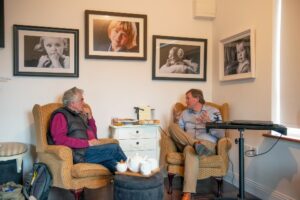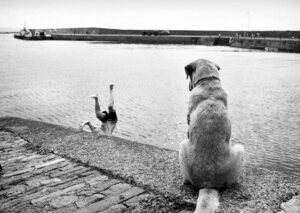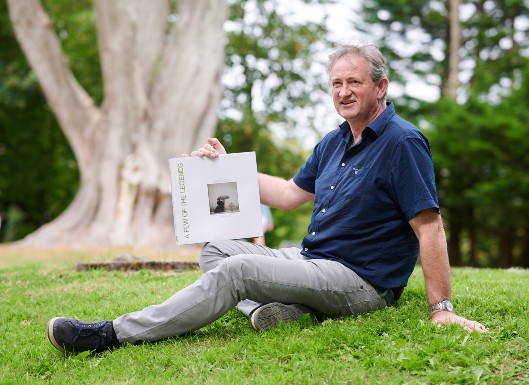SOMETIMES raw and always authentic, John Kelly’s photographs capture Clare in all its glorious, local detail.
His pictures have a universal quality too. They celebrate humanity in all its forms and colours. They bear witness to moments and events that are truly extraordinary. They also find the magic in ordinary people going about their ordinary lives.
From the intense stare of a rain-soaked Davy Fitzgerald, grappling with a defeat to Tipperary; to the serene faces of pilgrims at St Brigid’s Well in Liscannor, John Kelly’s interest lies in revealing what is going on beneath the surface.
A multi-award winner, John has been honoured many times by his peers. He has been personally singled out for praise by some of the greats of photojournalism including the UK’s Martin Parr and, most recently, by acclaimed portrait photographer, Peter Adams. As part of the Australian’s 40-year mission to track down some of the world’s best photographers, Peter came to Ireland to interview John for his new book, A Few of the Legends. The beautifully-illustrated tome places The Champion’s staff photographer on a par with Joe Rosenthal, Lord Snowdon and Annie Leibovitz.
As part of Peter’s marathon project, which began in 1982, he cast his net wide to find ‘legends’ who truly represent all facets of photography. After discovering John’s work online, he instantly recognised both the local and the universal qualities.
“I was looking for a local Irish photographer, and a Scottish photographer, working on a rural paper,” Peter explained. “And I searched the internet looking at photographs that covered local issues. There were many photographs, but few had the sense of storytelling, empathy and – in JK’s case – irony I was looking for.”
Speaking from New South Wales, the Katoomba photographer told The Champion he believes John’s talent lies in an ability to keep seeing his local area in a fresh light. “It’s easy working for a national paper like the Washington Post,” he said.
“They have the resources to cover big stories. John doesn’t have wars or volcanoes or dramatic scenes laid out before his eyes. He has to find compelling images within a relatively small geographic space. That’s not easy.
“I wanted to make the point that you don’t need huge resources and big stories to create great storytelling. Great storytelling is often right in front of us. Under our noses, as it were. Within a radius of 40 miles, JK has managed to tell great stories filled with empathy, sensitivity and humour. It shows in his photographs.”

Inclusion in A Few of the Legends is very definitely a career highlight for John. “Apart from the fact that I’m delighted to be in such a book, it’s a book that I would be hugely interested in anyway,” he said. “What I love about it is that it’s about photography and photographer’s thought-processes. It’s not about gear, technique or anything like that. It’s the back story to photographers and photographs.”
John agreed with Peter’s comments on the challenge of constantly capturing what is fresh and new. “One of the problems of working in such a small area is that you become so familiar with it, you don’t see it anymore,” he said.
“I was in Brussels a couple of years ago and for me to go out on the street there is completely different to going out on the street in Ennis.”
Explaining what it is like to be tasked with finding a Champion front-page shot, sometimes at short notice, John provided further insights into his own process.
“When it’s all wide open like that, I just relax and say, ‘It’ll happen”. I just go somewhere and just noodle about and hang around. If I even have an inkling that something might make a shot, you can be quite surprised and it can just develop in front of you. You realise, ‘My God, if I didn’t stop, I wouldn’t have got this’.”
A case in point is a recent phone conversation I had with John about photo markings. Midway through our chat, he spotted a man, his dog and a small cart, trundling along the eastern shores of Lough Derg.
So curious was John that he ran off immediately, camera in hand, to approach the stranger. Fifteen minutes later, he phoned back, having captured the picture, and the story, of 41-year-old German Karsten Rinck and his dog Lotte, on the Irish leg of a journey through 40 European countries. “I could have driven past,” John reflected. “But, I just said to myself, ‘Let’s see what this guy is doing.”
As daunting as it can be for both photographer and subject when an impromptu opportunity presents itself, John has developed a way of putting everyone at ease. He confesses to being a very shy person himself when he is without his camera. Once he is looking through the lens, his powers of persuasion are legendary.
“I had to learn that,” he said. “People can be very reluctant to be photographed. Sometimes, people can be a little bit stressed because the story can be that type of story. You need to show the person and the situation they are in. Most of the time I would succeed. What I try to do is give people time.
“Often, I would go and talk to someone for half an hour without even taking the camera out of the car. There’s a famous quote that I love from the photographer Cornell Capa who said, ‘Like people and let them know it’.”
For Peter’s book, John had the chance to stand on the other side of the lens for a change.
“Peter is an extraordinary portrait photographer,” he said. “There’s a lot to be learned from Peter. He has years and years of experience and that is shown in the individual photos he’s taken. He is so relaxing to deal with. He’s good fun, a people person and he doesn’t let technology get in the way. You don’t really know you’re in a photoshoot.”
Naturally creative and interested in technology, John began his career in photography at his sister Pat’s camera shop.
“She had a business with her boyfriend of the time, Joe Devaney,” John recalled. “The photographic process was quite technical back then. I got to like cameras as pieces of equipment. I didn’t want to save the world with a photo, but I would have known people who did. I learned how to process black and whites.
“One of the days, the late Liam McGrath, who used to work in The Clare Champion, came in. He saw some of my prints and asked me who made them. I said I did, and he asked if I would be interested in working for The Champion. I started part time in 1989.”
The bathroom in John’s family home in Mullagh served as his darkroom where he processed images of social events, fondly referred to as “grip and grin” pictures.
Running an extension cable into the bathroom and mixing his chemicals in the bath, John might work until 4am before bringing his prints, complete with hand-written captions, to the newsroom the next day. “I’d run down to The Champion and put the pictures on Frank O’Dea’s desk and that was the way I started out,” he recalled.
By his own admission, John began to work in press photography long before he knew anything about the greats of photojournalism.
While he is a great admirer of fellow photographers and a long-time and highly-regarded member of the Press Photographers Association of Ireland (PPAI), John takes his cue from sources closer to home. The benchmark for great work comes, he said, from “John and Mary public”.
“I had absolutely no training,” he said. “When I started doing pictures that might have been a little bit different from the grip and grins, they started to get noticed in the paper.
“On the street, someone might come up and say it to me. I have lots of letters, in the time before social media, from people. I remember covering an election count in 1992, I got a letter later from a woman who told me she loved my coverage.
“For me, that positivity from the general public in the county was great. During the beef crisis, I had a photo on the front page of two farmers at a Kilfenora mart, leaning on a fence, whispering together. A friend told me that his father really responded to that photo.
“The man wasn’t an art lover or a photo lover, but I knew then I was connecting to ordinary people. To me, that was the joy of it. I wasn’t thinking about awards or going any further. There was no internet, my pictures were only being seen in Clare.”
Nowadays, John’s pictures are known far beyond the Banner County. His body of work is very significant and he been awarded for work in categories including ‘Reportage’, ‘Portrait’, ‘Sports’ and ‘Features’. Asked about his own favourite image, John chose a shot of a dog watching from the pier as a young boy dives into the sea.

“It’s the picture that is included in A Few of the Legends,” he said. “I called it ‘Fetch Boy, Fetch!’ It won first in Features at the PPAI Awards.
“There’s a couple of layers to it. I think it’s my signature shot. For me, it’s a scene and it has a lot of the things I look for. It’s a moment, it’s got role reversal, it’s humorous. The judges said it was the story of a summer’s day, told with wit and panache. It’s street photography. It’s what I like doing, looking at the twists and turns in life, seeing things from viewpoints others don’t see. For me, if I was to put a photograph on my gravestone, it would be that one.”
More details of the book, A Few of the Legends, are available on Peteradams.com.

